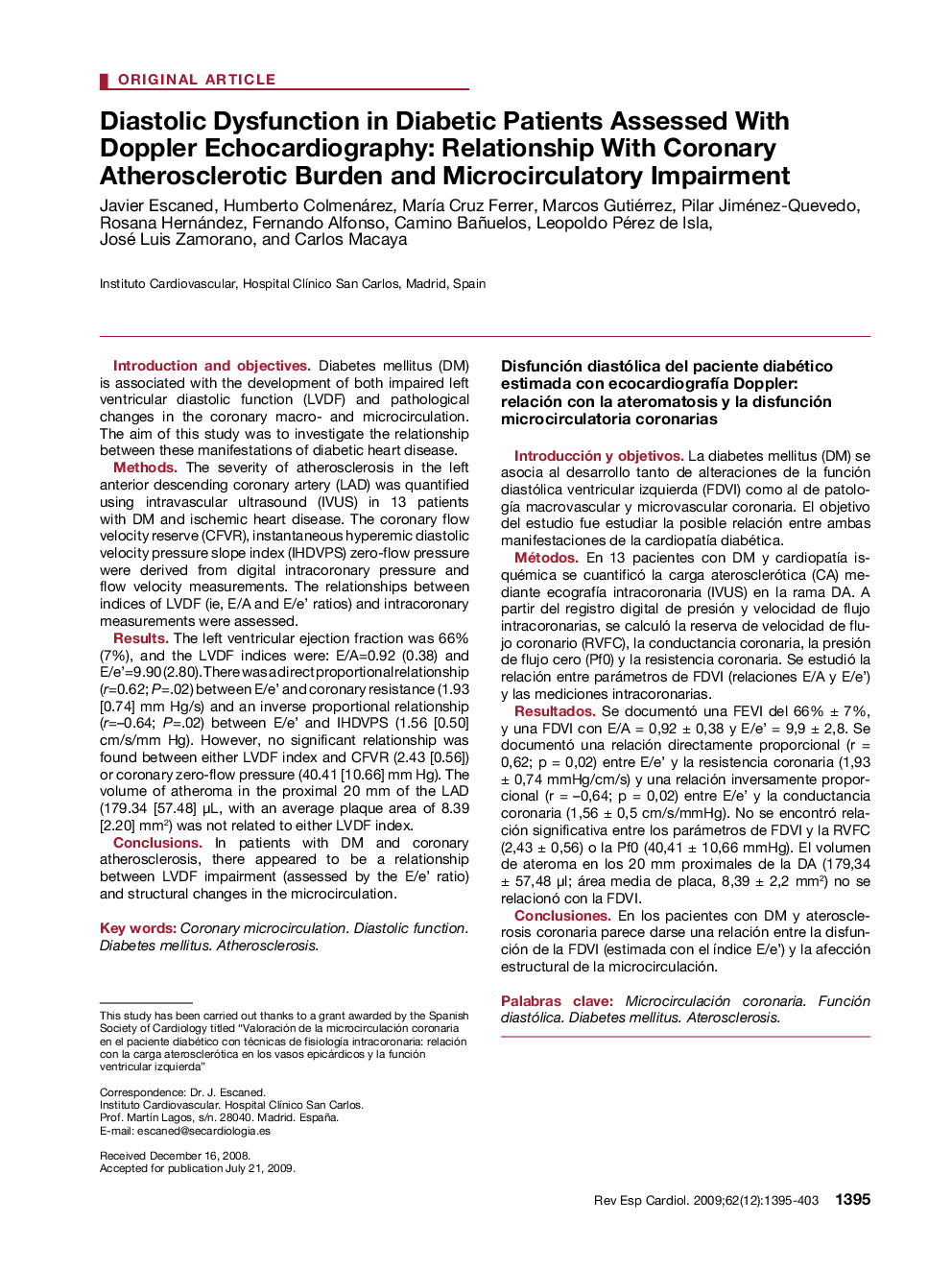| Article ID | Journal | Published Year | Pages | File Type |
|---|---|---|---|---|
| 3018829 | Revista Española de Cardiología (English Edition) | 2009 | 9 Pages |
Introduction and objectivesDiabetes mellitus (DM) is associated with the development of both impaired left ventricular diastolic function (LVDF) and pathological changes in the coronary macro- and microcirculation. The aim of this study was to investigate the relationship between these manifestations of diabetic heart disease.MethodsThe severity of atherosclerosis in the left anterior descending coronary artery (LAD) was quantified using intravascular ultrasound (IVUS) in 13 patients with DM and ischemic heart disease. The coronary flow velocity reserve (CFVR), instantaneous hyperemic diastolic velocity pressure slope index (IHDVPS) zero-flow pressure were derived from digital intracoronary pressure and flow velocity measurements. The relationships between indices of LVDF (ie, E/A and E/e’ ratios) and intracoronary measurements were assessed.ResultsThe left ventricular ejection fraction was 66% (7%), and the LVDF indices were: E/A=0.92 (0.38) and E/e’=9.90 (2.80). There was a direct proportional relationship (r=0.62; P=.02) between E/e’ and coronary resistance (1.93 [0.74] mm Hg/s) and an inverse proportional relationship (r=−0.64; P=.02) between E/e’ and IHDVPS (1.56 [0.50] cm/s/mm Hg). However, no significant relationship was found between either LVDF index and CFVR (2.43 [0.56]) or coronary zero-flow pressure (40.41 [10.66] mm Hg). The volume of atheroma in the proximal 20 mm of the LAD (179.34 [57.48] μL, with an average plaque area of 8.39 [2.20] mm2) was not related to either LVDF index.ConclusionsIn patients with DM and coronary atherosclerosis, there appeared to be a relationship between LVDF impairment (assessed by the E/e’ ratio) and structural changes in the microcirculation.
Introducción y objetivosLa diabetes mellitus (DM) se asocia al desarrollo tanto de alteraciones de la función diastólica ventricular izquierda (FDVI) como al de patología macrovascular y microvascular coronaria. El objetivo del estudio fue estudiar la posible relación entre ambas manifestaciones de la cardiopatía diabética.MétodosEn 13 pacientes con DM y cardiopatía isquémica se cuantificó la carga aterosclerótica (CA) mediante ecografía intracoronaria (IVUS) en la rama DA. A partir del registro digital de presión y velocidad de flujo intracoronarias, se calculó la reserva de velocidad de flujo coronario (RVFC), la conductancia coronaria, la presión de flujo cero (Pf0) y la resistencia coronaria. Se estudió la relación entre parámetros de FDVI (relaciones E/A y E/e’) y las mediciones intracoronarias.ResultadosSe documentó una FEVI del 66% ± 7%, y una FDVI con E/A = 0,92 ± 0,38 y E/e’ = 9,9 ± 2,8. Se documentó una relación directamente proporcional (r = 0,62; p = 0,02) entre E/e’ y la resistencia coronaria (1,93 ± 0,74 mmHg/cm/s) y una relación inversamente proporcional (r = −0,64; p = 0,02) entre E/e’ y la conductancia coronaria (1,56 ± 0,5 cm/s/mmHg). No se encontró relación significativa entre los parámetros de FDVI y la RVFC (2,43 ± 0,56) o la Pf0 (40,41 ± 10,66 mmHg). El volumen de ateroma en los 20 mm proximales de la DA (179,34 ± 57,48 μl; área media de placa, 8,39 ± 2,2 mm2) no se relacionó con la FDVI.ConclusionesEn los pacientes con DM y aterosclerosis coronaria parece darse una relación entre la disfunción de la FDVI (estimada con el índice E/e’) y la afección estructural de la microcirculación.
